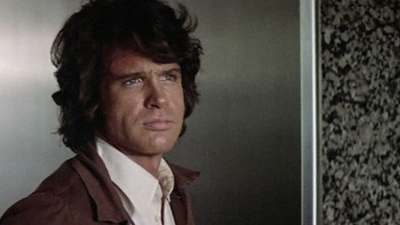[LIGHTS DIM; VIDEO STARTS PLAYING]
Many of my favorite films have endings that most people would consider unhappy. But I don’t. To me, the only ending that makes me unhappy is the wrong ending. “The Parallax View,” the 1974 paranoid thriller starring Warren Beatty as a renegade reporter investigating the murder of a United States senator, has the right ending for the story it presents—the kind of ending that fills you with dread and despair, but might also make you laugh (bitterly, and with admiration) at its audacity.
The beginning and middle of the film are great, too. And right around the halfway point is a montage that I consider one of the finest demonstrations of the essence of film editing since the Russians of the 1920s stitched unrelated shots together to see if it alchemized feelings and meanings the shots could not convey in isolation.
Beatty’s character, Joe Frady, is a recovering alcoholic with anti-authoritarian tendencies. He lost his job as an investigative reporter at a Seattle newspaper and only recently got it back, but is now in danger of losing it again. It is implied, not directly stated, that part of Joe’s problem is that he’s traumatized by the events in the film’s opening sequence, the assassination of the Senator during a party in the restaurant atop the Space Needle. (It’s staged to evoke the assassination of Robert F. Kennedy in Los Angeles six years earlier, as well as the killings of JFK, MLK, Malcolm X, and other leaders.) Everybody in the film’s potential audience was traumatized by the instability of that era. “Parallax” spoke to some of the worst of it.
This was a time when, paraphrasing one of Joe’s lines, it seemed as if every time you turned around, somebody was knocking off a leader or trying to. Two years before “The Parallax View” came out, President Richard Nixon survived two assassination attempts, one of which ended with would-be murderer Arthur Bremer wounding independent presidential candidate George Wallace. A month after “Parallax” came out, a disturbed man named Samuel Byck tried to kill Nixon by hijacking a commercial airliner and crashing it into the White House. Somehow, the authorities always concluded that the killer or would-be killer was a mentally or emotionally disturbed person who had acted alone. After a certain point, that stock conclusion began to seem both chilling and absurd. The coda to the opening murder captures ’70s skeptical ennui perfectly: A Warren Commission-like body of judges releases the results of their investigation into the senator’s murder, which concludes that the killer acted alone and “there is no evidence of any wider conspiracy; no evidence whatsoever.”

